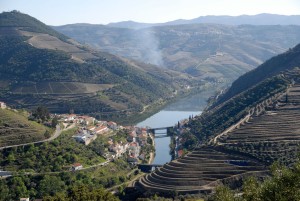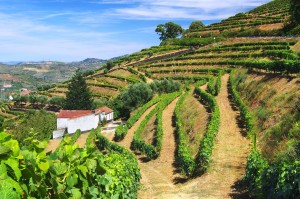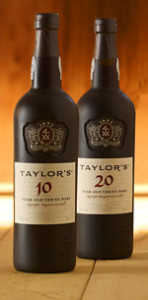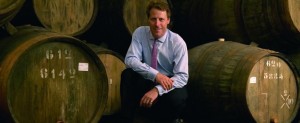Today we have a conference preview from Adrian Bridge, the CEO of the Fladgate Partnership and The Yeatman Hotel. Adrian gives us a preview of his session entitled ““Mature Tawny Ports: The Art of Aging and Blending.”
Taylor’s aged Tawnies—10-, 20-, 30- and Over 40-Year-Old—are not only as significant a part of the business as Late-Bottled Vintage Port, but they have grown in importance, a trend which seems set to continue as more and more people discover them. Already the 20-Year-Old is the most popular pouring Port in restaurants in the US and the 10-Year-Old is the leading aged Tawny in Britain. Back home in Portugal, Taylor’s has been adding to its stocks of maturing Tawnies since the mid-1990s, so much so that Tawny stocks now top all other styles.
Aged Tawnies are blends of the wines of several different years, each batch blended to match the last (and labelled, incidentally, with an age which is a guide, not a mathematical calculation). A bottle of Taylor’s 10-Year-Old bought this year will taste the same as one bought last year and one bought in five years’ time.
Being more delicate in taste than bottle-matured Ports they start life in the same way. What makes them different is the way they’re matured. But first, they have to be chosen.
Early in the new year samples of the 200 or so Ports from the previous harvest—from Taylor’s own quintas and from farmers with whom it has contracts (some dating back a century)—are sent down from the Douro to Vila Nova de Gaia for tasting, categorising and classifying into the various styles: potential Vintage, Late-Bottled Vintage, 10-, 20-, 30- and 40-Year-Old Tawny, and so on.
So far, so simple; but the classification tasting is anything but simple. Aged tawnies are blended not at the beginning of their life, but at the end, which means that the tasters—David Guimaraens, head winemaker and his team—are not only assessing quality now, but predicting the outcome of wines that will remain in cask for years, if not decades.
The aged Tawny process starts, then, with the tasting of the new wines—always blind, every morning over a period of several weeks at the beginning of each year. “We’re getting into the soul of the wine, really getting to know it, which is why we don’t do more than about 20 a day. It’s the only time we see all these wines together like this,” says David Guimaraens. Their notes and scores are fed into the computer and matched up to each wine’s vital statistics (origin, quantity, chemical analysis) to produce a complete profile, one sheet for each wine.
So what does make a 10-Year-Old or a 40-Year-Old? Ports selected for a 10-Year-Old Tawny are likely to be from the same group as for Late-Bottled Vintage; those destined to be 30- and Over 40-Year-Olds are likely to be from Taylor’s own quintas and to be material of Vintage Port quality which hasn’t made the final cut. A future 40-Year-Old might be slightly lighter in colour than the wines selected for the Vintage; it might be more delicate, perhaps a bit more floral; it might come from a very good part of the quinta, but one that doesn’t produce quite the intensity required for a top Vintage Port.
It follows that just as Taylor’s doesn’t have the quality to produce a Vintage Port each year, it doesn’t set aside port for 30- and Over 40-Year-Old Tawnies every year. The aim is always to have suitable material for 10- and 20-Year-Olds, but nature can thwart even this: 1993 produced no aged Tawnies; and 2002 yielded nothing suitable for 20-Year-Old and above.
Selecting the right quality and style is only the beginning. The Ports destined to be Tawnies are stored in the company’s lodges in Vila Nova de Gaia and the new temperature- and humidity-regulated facility in the Douro. Here they are nurtured and guided so that they develop in keeping with the Taylor’s Tawny style. Key elements of this are freshness, fruitiness and finesse; complexity and nuttiness, too; but always avoiding the more oxidised ‘Douro bake’ character which comes from ageing in the hot, dry conditions of the Douro and from racking and refreshing the wines infrequently.
Racking, separating the wine from its sediment (including the colouring matter; hence the final tawny colour) and aerating it, is done more often early on, gradually reducing to annually. Refreshing a Tawny—“giving it something to chew on” (to translate an evocative Portuguese expression)—is, as you might expect, the blending in of some younger Port. Both procedures are critical in the evolution of aged Tawnies.
Alongside the racking and refreshing team, another is kept busy in the cooperage repairing casks. ‘The casks stay with us forever,’ David says (as do many of the staff, as it happens). Oak is used because its tight grain allows the ideal slow oxidation, but it’s always well-seasoned, never new. The last thing anyone wants is the sweet vanilla taste of new oak; port has enough flavour and sweetness of its own. Size matters, too: most of the Tawnies are in pipes (casks of 600-640 litres), but any that need refreshing may be moved from cask to large vat to slow the ageing.
With selection and classification at the beginning of the year and quality control ongoing, what remains is the all-important blending in November, the quiet after the storm of the harvest period.
Blending the aged Tawnies is thus anything but whimsical or random. It requires exceptional tasting skills, but also a dab hand with a calculator. As David and his team pick their way through 50 or 60 potential components for the 10-Year-Old, lined up round the tasting room with the age of each written in front on the counter, they are calculating both the average age and the quantity that will result: 140 pipes of number three (the age of which is seven years, ten month)—“lovely zing and bite”—76 pipes of number 27 (aged ten years eight months); four pipes of 51 (20 years three months years)—“for complexity”. It takes a couple of mornings to do the 10-Year-Old; less to do a 40-Year-Old because there are fewer possible components. But the 40-Year-Old will have a wider variation of age. The current Over 40-Year-Old may contain some wine from the 1930s, but with younger wines to bring the age to within a few years either side of 40.
Blends chosen, the blending itself is done, the finished tawnies are bottled and within months they’re shipped. The rest is our job: drinking them.
Click here to download the Tasting Notes – Taylor Tawny Ports
About the speaker: Adrian Bridge is the CEO of the Fladgate Partnership and The Yeatman Hotel. Adrian has worked for Taylor’s since 1994 and in 2000, formally took over the role of Managing Director of the Taylor Fonseca Port Group. Having been instrumental in the group of buying the assets of Borges Port in 1998, he further expanded the company with the purchase of Croft Port and Delaforce Port in 2001, from Diageo. The subsequent reorganization of the group, to form The Fladgate Partnership, and repackaging of these brands has helped the group to become a leading supplier of Port in the major premium markets of the world. Adrian is the creative force behind The Yeatman, a project that he started in 2006. He was involved in every detail of the project: design, branding and launch of the hotel.
Adrian’s session, “Mature Tawny Ports: The Art of Aging and Blending” will be held on Saturday, August 12, 2017 at 4:45 pm as part of SWE’s 41st Annual Conference, to be held August 10 – 12, 2017 in Portland Oregon.




